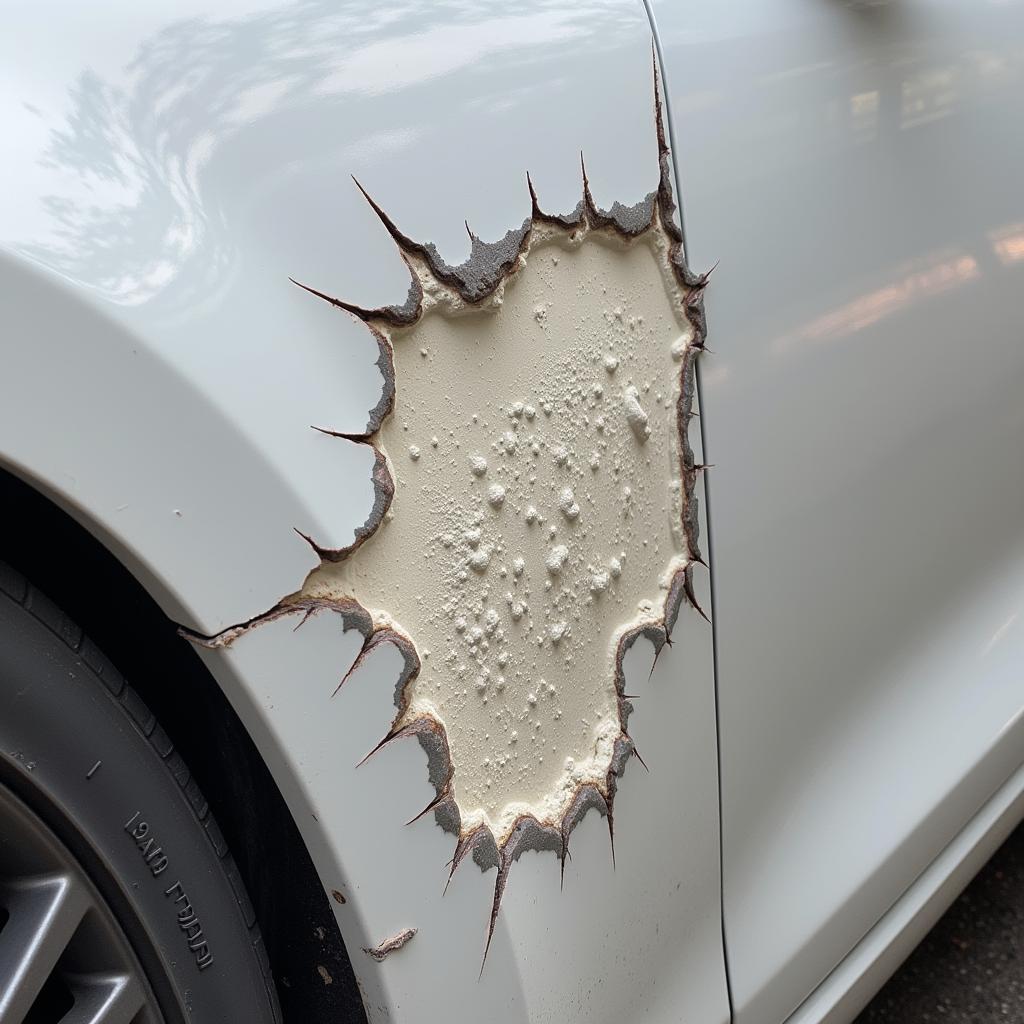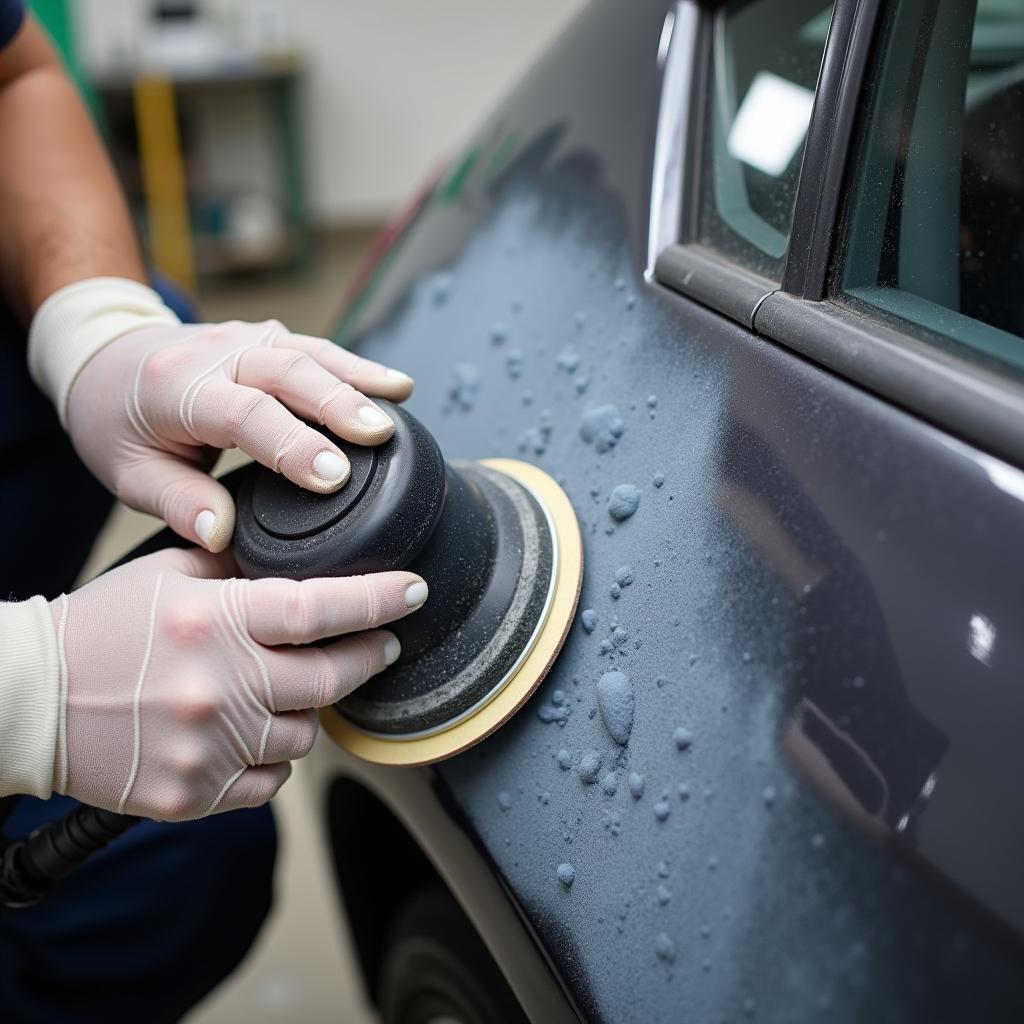Bubbling car paint is a common issue that can detract from your vehicle’s appearance and potentially lead to more serious problems like rust. This guide will walk you through the causes, How To Fix Bubbled Paint Car, and preventive measures. Let’s get started!
 Close-up view of bubbling car paint
Close-up view of bubbling car paint
Understanding the Causes of Bubbling Paint
Before diving into how to fix bubbled paint car, understanding the root cause is crucial for effective repair and prevention. Bubbling usually indicates a loss of adhesion between the paint layers or between the paint and the underlying metal. Several factors can contribute to this issue:
- Moisture: Trapped moisture is a primary culprit. This can be due to leaks, improper washing and drying, or high humidity.
- Poor Surface Preparation: If the surface wasn’t properly cleaned and primed before painting, the paint can fail to adhere correctly, leading to bubbling.
- Sun Damage: Excessive sun exposure, especially UV rays, can weaken the paint’s chemical bonds, making it prone to bubbling and peeling.
- Chemical Exposure: Contact with harsh chemicals, such as road salt, bird droppings, or industrial pollutants, can damage the paint and cause it to bubble.
- Impact Damage: Minor impacts, like rock chips or hail damage, can create tiny cracks that allow moisture to seep in and cause bubbling.
How to Fix Bubbled Paint Car: A Step-by-Step Guide
Fixing bubbling paint requires a systematic approach. Here’s a comprehensive guide to help you through the process:
- Assess the Damage: Carefully inspect the affected area to determine the extent of the bubbling.
- Gather Your Supplies: You’ll need sandpaper (various grits), primer, paint that matches your car’s color, clear coat, masking tape, a scraper, and safety equipment (gloves and eye protection).
- Prepare the Area: Clean the affected area thoroughly with soap and water. Use a scraper to remove any loose or flaking paint.
- Sand the Area: Start with coarser grit sandpaper to remove the remaining bubbled paint and smooth the surface. Gradually move to finer grits for a smooth finish.
- Apply Primer: Apply a thin, even coat of primer to the sanded area. Allow it to dry completely according to the manufacturer’s instructions.
- Paint: Apply several thin coats of paint, allowing each coat to dry before applying the next. Ensure the color matches your car’s existing paint.
- Apply Clear Coat: Once the paint is dry, apply a few coats of clear coat to protect the paint and give it a glossy finish.
- Finishing Touches: After the clear coat has dried, lightly sand with very fine grit sandpaper and buff for a smooth, even finish.
 Sanding the affected area of bubbling car paint
Sanding the affected area of bubbling car paint
Preventing Bubbling Paint
Preventing bubbling paint is often easier than fixing it. Here are some proactive steps you can take:
- Regular Washing and Waxing: Regularly wash and wax your car to protect the paint from environmental contaminants and UV rays. how to fix rust spots on car
- Proper Drying: Dry your car thoroughly after washing, paying attention to areas where water can trap.
- Address Leaks Promptly: If you notice any leaks, fix them immediately to prevent moisture from getting trapped under the paint.
- Park in Shade: Whenever possible, park your car in the shade to minimize sun exposure.
- Touch-up Paint Chips: Address paint chips promptly to prevent moisture from entering and causing bubbling.
“Regularly inspecting your car’s paint for any signs of bubbling is key. Early detection can save you time and money down the road,” says John Smith, Automotive Paint Specialist at Autotippro.
Conclusion
Bubbling car paint, while unsightly, is a fixable problem. By understanding the causes and following the steps outlined in this guide, you can restore your car’s appearance and prevent further damage. Remember, consistent maintenance and prompt attention to minor issues can significantly extend the life of your car’s paint. If you need professional assistance, feel free to connect with us at Autotippro. Our team is here to help! Call us at +1 (641) 206-8880 or visit our office at 500 N St Mary’s St, San Antonio, TX 78205, United States.
“Prevention is always the best approach. A good car care routine can significantly reduce the risk of bubbling paint,” adds Sarah Jones, Senior Technician at AutoTipPro.
FAQ
-
Can I fix bubbled paint myself? Yes, with the right tools and patience, you can fix minor bubbling at home. However, extensive damage may require professional attention.
-
What if the bubbling comes back after I fix it? This could indicate a deeper underlying issue, such as rust or a persistent leak. It’s best to consult a professional for further diagnosis and repair.
-
How long does the repair process take? Depending on the extent of the damage, the repair process can take a few hours to a couple of days, including drying time.
-
What type of paint should I use for touch-ups? Always use automotive paint specifically designed for your car’s make and model to ensure a perfect color match. how to fix rust spots on car
-
Is it necessary to use a clear coat? Yes, a clear coat protects the paint from UV rays, environmental contaminants, and minor scratches.
-
How often should I wax my car? Waxing your car every three to six months is recommended to maintain the paint’s protective layer.
-
What can I do to prevent rust after fixing bubbled paint? Ensure all affected areas are thoroughly cleaned and treated before repainting. Applying a rust inhibitor can also provide additional protection.




Leave a Reply